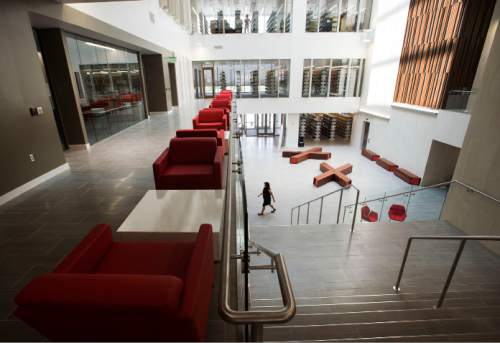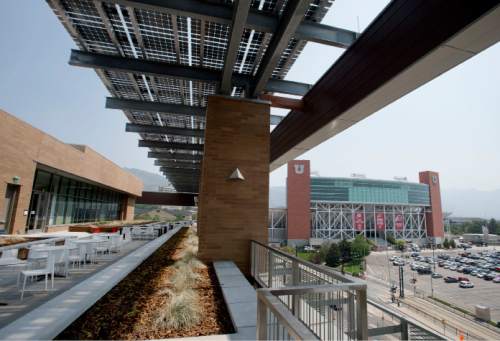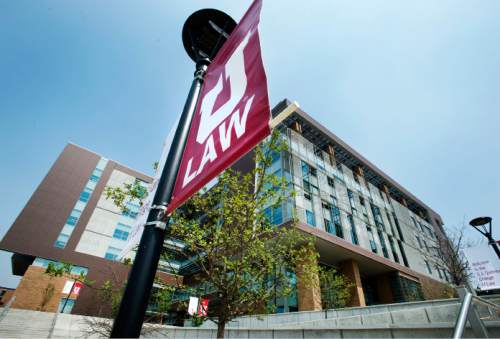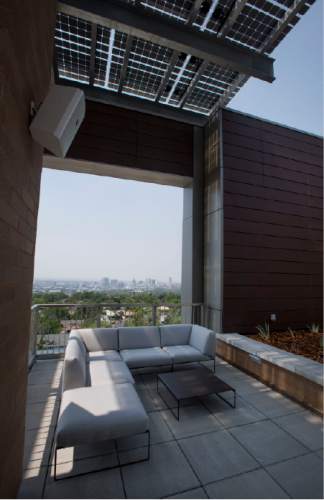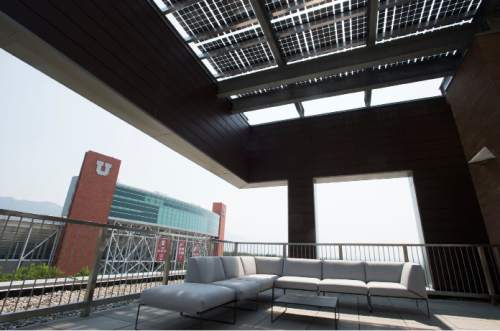This is an archived article that was published on sltrib.com in 2015, and information in the article may be outdated. It is provided only for personal research purposes and may not be reprinted.
Sitting in the sun-dappled atrium of the University of Utah's new S.J. Quinney College of Law Friday, Matt Cloward was impressed by the amount of natural light.
"Hopefully it's not a distraction," he said, admiring the large windows. The old law school building due north has only tiny windows in the backs of its classrooms.
"I like the idea of being able to look around," Cloward said.
A grand opening for the new building is scheduled for Tuesday. But U. law students and faculty have already moved in, stepping around construction areas while preparing for the start of fall semester next week.
The shiny new building has been recognized for its energy-efficiency and green materials. At the same time, some longtime campus residents lament the loss of the historic building it replaced.
Students, meanwhile, are just trying to get a sense of the place.
Jaron Janson, a transfer student from Arizona, said he was surprised by how much work had been done since he first visited campus earlier in the month.
"There were wires hanging everywhere and no chairs," he said. "It was totally different."
Cloward, a second-year law student, wonders what will fill the role of the old building's large reading room, where students would gather between classes.
"There's not an obvious space," he said. "I'm sure we'll find something, but I don't know where it's going to be yet."
The $62.5 million building, located at the southwest corner of campus across from Rice-Eccles Stadium, was envisioned as a gateway to the University of Utah, according to Robert Adler, the law school's dean.
The school was designed with a focus on accessibility and sustainability, he said, and will better serve the needs of students by incorporating space for trial simulations, client interaction and visiting members of Salt Lake City's legal community.
"What we're trying to do is train our students in a way that gets them to have professional responsibility," he said. "All these focal points that we have — matching doctrine and theory with training — we can now do better in the building."
But the new school also came with some historical cost, something Adler acknowledges was a "sore point" for many members of the university community.
The building site was previously occupied by Carlson Hall, the University of Utah's first women's residence hall, which was listed on the National Register of Historic Places in 1996.
Adler said there was some discussion about renovating Carlson Hall. But the seismic conditions were so poor that bringing the building up-to-date would have been prohibitively expensive.
"The [Carlson Hall] building had way more historic value than architectural value," he said. "It wasn't a very nice building."
The university negotiated with the state to preserve the history of Carlson Hall, Adler said. Documents from the residence hall will be preserved and displayed and information markers will be placed outside the new building.
"The cornerstone is going to be a bench," Adler said. "We're going to show people where Carlson Hall was."
For now, the old law school building will be used for storage.
A listing on the National Register of Historic Places doesn't preclude new construction, according to Nelson Knight, tax program coordinator for the Utah Division of State History.
He said Carlson Hall had historical significance, but it's ultimately up to the university to weigh building needs.
"As the university changes, there are tradeoffs that need to be made," he said. "It has become a premier institution. It's part of the Pac-12 now, and I guess they needed a bigger law school."
Beyond housing the law school, Adler said, the new building creates a more accessible entrance to a corner of campus where tens of thousands of visitors arrive by public transit each day.
The land around the law school has been regraded to comply with the Americans with Disabilities Act, he said, and the layout accommodates sight lines and acoustics for individuals with disabilities.
"When you make a building accessible for people with disabilities, everyone else benefits, too," he said.
The building also boasts a number of environmental features — from solar paneling to a water-based cooling system that taps into an artesian well near the stadium.
"We're recycling the sink water to flush the toilets," Adler said. "The plumbers were anxious about it, but we're pushing the envelope."
Adler said architects set out to design the most sustainable law school building possible. The finished product ultimately earned a platinum LEED certification, a design recognition that rewards green building practices.
Sustainable design features were supplemented with a $4.5 million grant from the Alternative Visions Fund.
The college also received $15 million from the Quinney Foundation, $4 million from The Church of Jesus Christ of Latter-day Saints and several million dollars from alumni law firms.
"We are at about $43 million [in fundraising] and still working," Adler said.
Myron Wilson, deputy chief sustainability officer for the University of Utah, said the building exceeds the university's energy efficiency standards. The building is "impressive," he said, noting features like the water-cooling system and a unique glass that looks like a spider web to birds in order to deter collisions.
"It does a lot of things that I'm really excited about," Wilson said.


